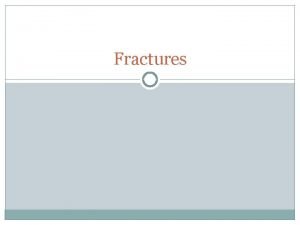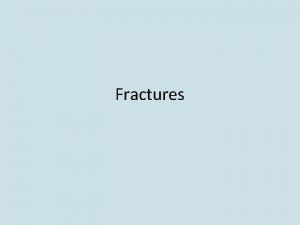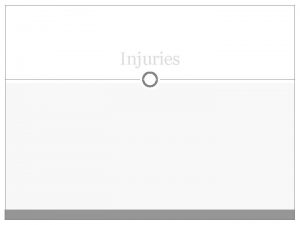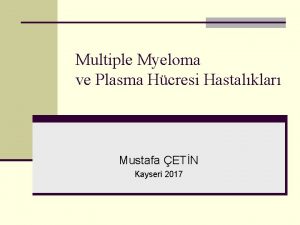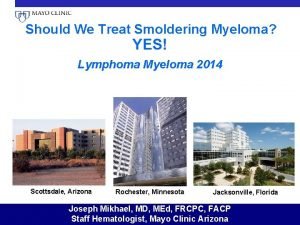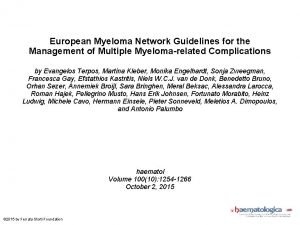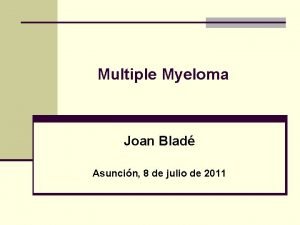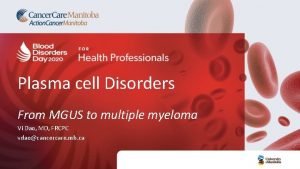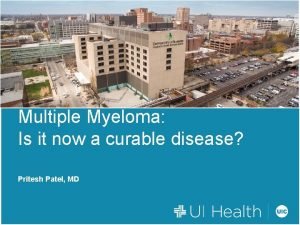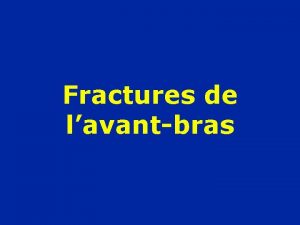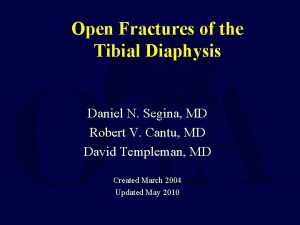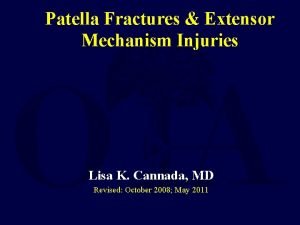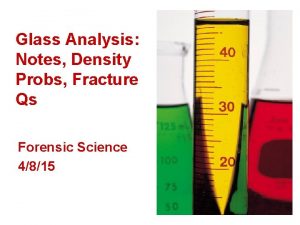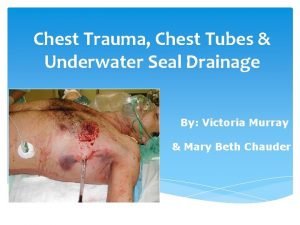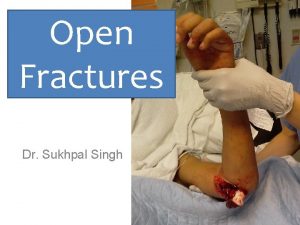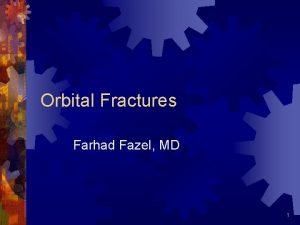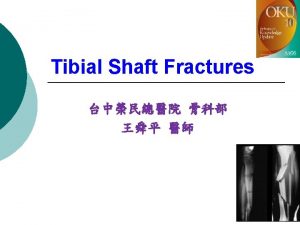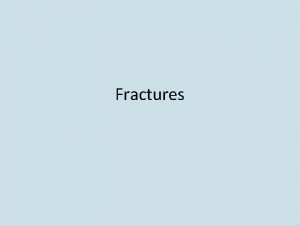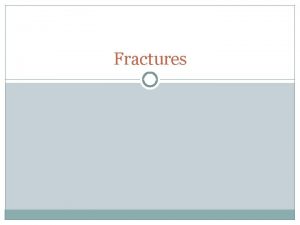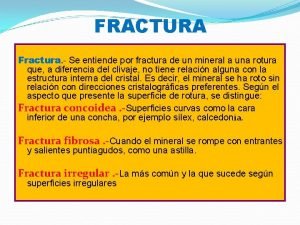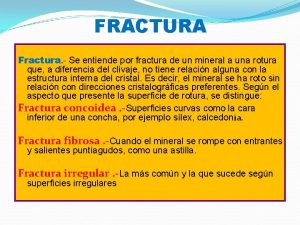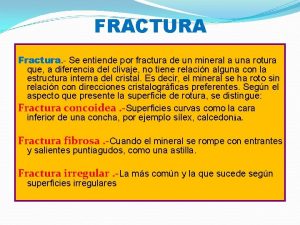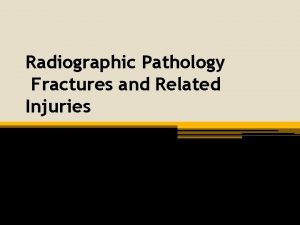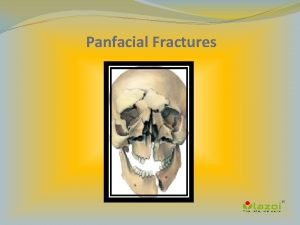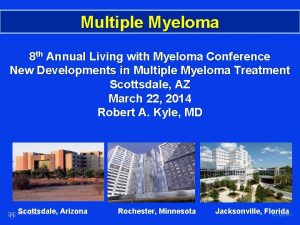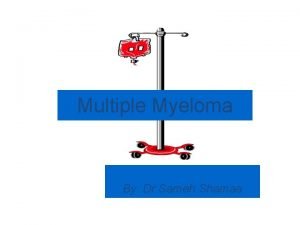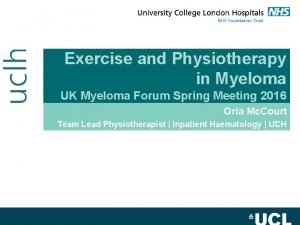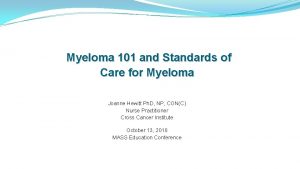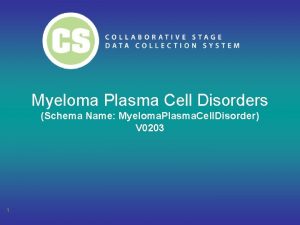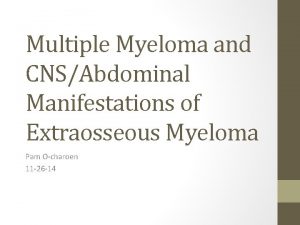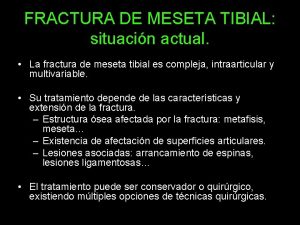Fractures Fractura pathologica Myeloma Fractura traumatica Fractura apertaclausa




























- Slides: 28

Fractures

Fractura pathologica Myeloma

Fractura traumatica

Fractura aperta/clausa

Fractura simplex/multiplex

Fractura comminutiva

Fractura transversa/obliqua

Fractura spiralis/longitudinalis

Fractura compressiva/impressiva

Fractura incuneata

Infractio = f. partialis = f. incompleta

Fractura cum dislocatione ad axim ad latus ad longitudinem cum contractione ad longitudinem cum distractione

AO Classification of fractures Authentic reports : 2 S 4220 Fractura colli chirurgici humeri l. dx. comminutiva AO 11 -C 3

Fracture Healing: 1: REPOSITIO = REDUCTIO fragmentorum CLOSED (short /long term)

Fracture Healing: 2: FIXATIO = STABILISATIO fragmentorum PLASTER CAST INTERNAL FIXATION

Fracture Healing: 2: FIXATIO = STABILISATIO fragmentorum INTERNAL FIXATION

Fracture Healing: 2: FIXATIO = STABILISATIO fragmentorum

Name the type of fracture A B C D E F

Choose a bone and break it. Try to write as much detailed diagnosis as possible.

Authentic reports : 1 De collement = severe damage of soft tissues

Authentic reports : 2 Fr. aperta TSCHERNE I - open fracture with small skin injury without its contusion - negligible bacterial contamination Profesor Dr. Harald Tscherne (1933), Traumatology Clinic, Hannover: Classification of fractures published in 1982, T. divides fracture into open and closed. The most important for him is the degree of the soft tissues damage.

Authentic reports : 3

1 A 45 -year-old woman presented with a 3 -month history of generalized body pains nonresponsive to analgesic agents. Along with low back pain, she had progressive difficulty in getting up from sitting and supine positions and in walking. There was no history of trauma or any medication intake. She is an orthodox believer who wears a black veil outdoors and is completely covered, with little exposure to the sun. An anteroposterior radiograph of the pelvis showed an undisplaced transverse fracture of the shaft of both femurs. The patient was treated with therapeutic doses of calcium and vitamin D supplements.

2 An 18 -year-old slightly intoxicated man was assaulted with a glass bottle on the left parietal region of his head and had a 5 minute loss of consciousness. Two hours after the injury he was presented to a local emergency with severe headache, nausea, and repeated vomiting. Computed tomography of the head revealed a 2. 5 -cm epidural hematoma in the left parietal region (Panels A and B) underlying a linear nondisplaced skull fracture (Panel C, arrows).

3 A 21 -year-old man presented after being struck with a gun on his right lower jaw. Examination revealed displacement of the left half of his mandible with malocclusion on biting (Panel A). Computed tomography showed a fracture of the left mandible and a fracture of the right mandibular body and angle (Panel B). Given the U shape of the mandible, it is common for contralateral fractures to result from major injury. Intravenous analgesics and antibiotics were given; the patient underwent open reduction with internal fixation of his fractures.

4 A 26 -year-old man was admitted to this hospital because of back pain and a mass in the lung. He had been well until 17 days before admission, when he bent down to lift something and felt a sudden snap in his back, followed by pain that was associated with profuse diaphoresis and muscle spasms that extended from the left shoulder to the buttocks but did not radiate to the legs. He was unable to stand up straight and had difficulty breathing and sleeping because of the pain. The next day, magnetic resonance imaging (MRI) of the spine at that facility revealed a pathologic T 9 vertebral fracture with soft-tissue extension beyond the vertebral body, a chronic anterior wedgecompression fracture of the L 1 vertebra, degenerative changes in the L 5–S 1 intervertebral joint, and a large pleural effusion on the left side.

5 A 34 -year-old man was brought to the emergency department at the hospital because of multiple traumatic injuries that he sustained when a bomb exploded while he was watching the 2013 Boston Marathon. At the scene, the patient reportedly lost consciousness, had a complete amputation of his right leg directly below the knee, and had copious blood loss. A plain radiograph of the left tibia and fibula (Figure 3 A Radiographs of the Injuries of the Left Leg. ) revealed multiple metallic foreign bodies around the knee and a nondisplaced fracture of the lateral tibial plateau. Plain radiographs of the left foot and ankle revealed a comminuted fracture of the calcaneus (Figure 3 B), minimally displaced cuboid and cuneiform fractures, and subluxation of multiple tarsometatarsal joints, evidence of a ligamentous Lisfranc injury (dislocation of the tarsometatarsal joints due to midfoot trauma; named after the military surgeon in Napoleon's army) (Figure 3 C).

Literature • Mazánek, J. : Traumatologie orofaciální oblasti. Praha : Grada, p. 24 • http: //radiologymasterclass. co. uk • http: //anthropology. si. edu • http: //nejm. org (The New England Journal of Medicine)
 Fractura simplex
Fractura simplex Comminutiva
Comminutiva Fractura multiplex
Fractura multiplex Sexualizacion traumatica
Sexualizacion traumatica Laesio traumatica superfic nasi
Laesio traumatica superfic nasi Myeloma cure on the horizon
Myeloma cure on the horizon Anita waldmann
Anita waldmann Vtd protocol multiple myeloma
Vtd protocol multiple myeloma Kpd myeloma
Kpd myeloma Hipercalsemi
Hipercalsemi Smoldering lymphoma
Smoldering lymphoma European myeloma network
European myeloma network Mayo clinic multiple myeloma
Mayo clinic multiple myeloma Waldenstrom macroglobulinemia vs multiple myeloma
Waldenstrom macroglobulinemia vs multiple myeloma Crab criteria multiple myeloma
Crab criteria multiple myeloma Smoldering myeloma
Smoldering myeloma Myeloma
Myeloma Pritesh patel md
Pritesh patel md Exercise physiology mascot
Exercise physiology mascot øpas
øpas Classification of open fractures
Classification of open fractures Lisa kasman
Lisa kasman Activity 14-1 glass fracture patterns
Activity 14-1 glass fracture patterns Triradiate cartilage
Triradiate cartilage Chest tube landmarks
Chest tube landmarks Danis and weber classification
Danis and weber classification Classification of open fractures
Classification of open fractures Types of fractures with pictures
Types of fractures with pictures Gustilo anderson classification antibiotics
Gustilo anderson classification antibiotics
